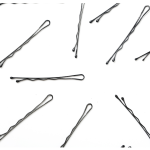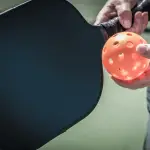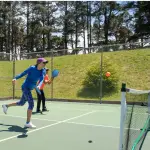Do you want to know the optimal location for a third shot drop, where to hit the serve return, or which women’s doubles player pro Anna Leigh should have has as a partner? In this episode, you can get answers to all of these questions as I talk to Alex Spancake from Pickle Mart where we dive into data analytics and Pickleball.
Mentioned in the Show
Show Notes
- In this episode, Lynn interviews Alex Spancake, a data analyst and pickleball enthusiast who has created a platform called Pickle Mart that uses data analysis to provide unique insights into the game of pickleball.
- Introduction – Alex talks about his background in data analytics, his introduction to pickleball, and the creation of Pickle Mart.
- Importance of Data in Pickleball – Alex discusses how data analysis can enhance the game, from understanding your own performance to studying professional players.
- Strategy & Positioning – Alex shares findings from his analysis on return positioning, emphasizing the importance of a consistent return and the benefits of limiting the opponent’s angle.
- Skill Level Considerations – Lynn and Alex discuss the varying strategies for different skill levels, and the need for more data from 3.0 to 4.0 level players.
- Professional vs Recreational Play – Alex comments on the stark difference between professional and recreational play in terms of ball placement and consistency, which becomes evident through video analysis.
- Player & Team Analysis – Alex shares his in-depth analysis on professional player, Anna Leigh Waters, and her performance with different partners, emphasizing how the choice of partner can affect play style.
- Future of Pickle Mart – Alex shares his vision for Pickle Mart, including creating player profiles, team profiles, and using computer vision software to make data entry easier for users.
- Misconceptions & Insights – Alex talks about common misconceptions in pickleball and the valuable insights that can be gleaned from data, such as the optimal location for a third shot drop.
Click Here to Subscribe to the Pickleball Fire Podcast
Transcript
Lynn: Today, I’d like to welcome Alex Spancake to the Pickleball Fire Podcast. How are you doing today, Alex?
Alex: I’m doing well, how about yourself?
Lynn: I’m doing great since I got to play pickleball today. I like to start off the podcast with a little bit about your background and your history with pickleball. How long ago did you start playing and how did you get into it?
Alex: Sure, I started playing in the summer of 2021, one of the Covid summers. My uncle, who lives in a retirement-like area, thought I’d have a lot of fun with it. As a former tennis player, I fell in love with pickleball immediately. I found some people in my area who were also new to the sport, and I feel like I’ve been addicted ever since.
Lynn: And you actually play at quite a high level. We’re going to talk about something interesting today, as well as a bit about your background and how you progressed to the level you are now.
Alex: I just kept playing and grinding. I was a decent tennis player, playing pretty actively. I still think my singles game is better than my doubles, but I’ve been playing about four or five times a week, attending local tournaments. I try to drill whenever I can, and now I’m playing anywhere from a 4.5 to a 5.0 level.
Lynn: That’s cool. We connected because you have a really interesting platform for pickleball analytics. Given my background as a data analyst statistician, I’m always very interested in anyone doing anything related to analyzing pickleball because understanding our tendencies, how we make errors, other people’s tendencies, all helps us improve our game. Let’s start with how you created this and why?
Alex: On Super Bowl Sunday of 2022, I was watching a lot of pro pickleball and got irrationally upset whenever the commentators would say something like, “Oh, that was a great timeout to stop the momentum.” I started looking for competitive pickleball data to try and answer that question. Pickleball is a young sport, so the data wasn’t out there. I decided to apply my skillset and see if I could answer the question myself. That’s what prompted Pickle Mart, a data mart for pickleball.
Lynn: Have you been able to answer that question?
Alex: It’s funny, I think we have the data to answer it. I’ve just gotten so sidetracked, so I haven’t answered it yet.
Lynn: I’m really curious to know the answer, so please do let me know when you find out. Now, how did you create a system to collect that data? I’ve talked to many coaches on the podcast and a number of them are charting matches manually which is time-consuming and difficult. I think you’ve got a better method, can you talk a little bit about that?
Alex: Sure, when I started doing data collection, it really just started with who served the rally, how long was the rally, and what was the rally outcome. I’m not a programmer by trade, but I built a very basic interface to chart that data. When I started talking with my friends who also played, the kinds of questions they were asking required shot-level data. The app to collect the data had to evolve to collect shot-level information. The process of collecting data is still fairly manual, but the interface we have makes it really easy to build dynamic reports and link any given shot to a video timestamp for coaches who want to watch mechanics.
Lynn: I did take a look at some of your videos, and it’s a bit hard to describe on a podcast
Lynn: But with the different clicks of the mouse, what are some of the things that you’re able to track that become data points that you can then analyze later?
Alex: We can track the point of contact for each shot because users click on an image of a court. We can also infer the speed of a hand battle based on how fast users are clicking. The left and right-click features are used to indicate third shot drives versus drops and whether teams are stacking. All this data can be accumulated into match reports to help players identify strengths, weaknesses, and opportunities for growth.
Lynn: What do you think are some of the most helpful statistics that you’re collecting?
Alex: I think one of the most helpful stats is related to third shots. We can see not only drop versus drive percentages but also how successful these shots were. This data can show whether a player’s third shot drop led to a lot of dinks or whether their third shot drive was effective. Other important decisions include when and where to speed the ball up, where to place your return, and being able to review all your errors.
Lynn: Since you mentioned it, and I think you may have done a bit of analysis about that, let’s talk about where to return the ball. Assuming that ideally, you want to hit deep into the court, do you want to hit to the left, middle, or right?
Lynn: What’s the preference, Alex?
Alex: Yep. So, goal number one, right? Get the return in. None of this matters if you’re not consistently making a return, but assuming you can, like you said, depth is positively correlated with better outcomes. If you’re playing against two righties, what we have found is the best place to put the return if you’re returning from the right, is just to go straight down the line.
I think this is for two reasons. A, it really limits the angle that your opponent can work with, and it makes it very clear that you, as the returner, are going to cover the line and your partner is going to cover the middle. Also, you may be getting it to your opponent’s backhand which often, but not always, will be their weaker shot.
And we found that you gain a couple percentage points in win rates when you’re able to do that. Which, yeah, like, adding only three percentage points to my probability of winning doesn’t sound like a lot, but over the course of a match, it’s rather significant.
On the flip side, if you’re returning from the left side the location that you pick is a little less important. What we saw is like, I think honestly going middle or even going across a little bit may have been slightly more effective, but I don’t think anything was statistically significant there.
Lynn: Now that makes a lot of sense because if I’m serving from that right hand side and we are playing two people who are right-handed, a lot of times it probably will go to the backhand. But one thing I’m curious about is if you’re going down the line and you’re a little bit lower level player, it seems like you’ve got more tendency to hit that ball out not depth wise, but near the sideline as opposed to just going down the middle. Did you look at the different skill levels as you kind of looked at that analysis?
Alex: Yeah, so for this analysis, I split it up again, but I am pretty sure I limited it to whether I think it was like 4.0 or 4.5+ level play. But to your point, like if you’re going down the line and there’s a chance of you missing, I would completely agree. You should probably give yourself a little more of a margin.
But yeah, this paper was under the assumption that you are consistently making your returns. Unfortunately, we don’t have a ton of data right now for 3.0 to 4.0 level play. We do have some individuals that are starting to use the tool. And I think doing comparisons of, oh, like what is a good return at the 3.5 level versus what is a good return at the pro level. Like what are the differences? I think that’s a really fun analysis that we’ll get around to at some point.
Lynn: Yeah, and it, it, for me, it’s so different kind of watching video, especially if it’s in slow motion or you’ve got some ball tracking because a lot of people I think look at pickleball and maybe even see my age group, the senior pros playing, and we’re kind of like, well I can do that.
But then when you really look at the placement of the ball and the consistency, it truly is a really different game. I mean, there’s just no doubt about it, but that really comes out through the video and given the tools that you have, I think it will be really prevalent.
Alex: Yeah, no, I agree. I mean, the fact that pros are only missing 3% of their returns, that’s actually wild.
Lynn: Now do you analyze most of your matches that you play? Or how do you select the ones that you decide to go through the process and analyze?
Alex: Yes, I definitely try to analyze a good number of my own games. But we also recently did an analysis looking at the differences in play styles when Anna Leigh Waters played with different partners, Anna Bright and Catherine Parenteau. So it’s not just about improving my own game, but also understanding the dynamics of pro player games, because those are who people are generally interested in. But the tool is for anyone who wants to use it, whether you play recreationally, in tournaments, or simply enjoy watching the pros play. All that data is useful.
Lynn: And I was going to ask you about the article that you wrote on the Anna Waters decision. Most people who listen to the Pickleball Fire Podcast probably know who Anna Leigh Waters is. But with a little bit more background, normally her regular partner is her mom, Leigh Waters. But Leigh tore her ACL a while back, so she’s been playing with two other high-level players in the meantime, Anna Bright and then Catherine Parenteau. So what was the bottom line of your analysis? Because you did a really nice, in-depth, very detailed analysis, but what was the take-home points from that? Assuming that Anna Leigh Waters can’t play with her mom, who should she be playing with?
Alex: Thanks. Yeah, at a glance, that analysis basically said Anna Leigh is going to be fine either way, but the partner she chooses will dictate the kind of play style that she deploys. So when Anna Leigh played with Catherine, I think they played a little more of a traditional one-two setup where Catherine was setting Anna Leigh up, right? I think Catherine’s drop and drive, both playing with Anna Leigh and playing with other partners is extremely effective. And when you allow Anna Leigh to roam on the court, good things generally happen.
On the other hand, when Anna Leigh played with Anna Bright, they did a good job of setting each other up. It was one of those cases where either of them could really go in and dominate a firefight. But again, either decision, even if she plays with both of them, she plays with one or the other, I think Anna Leigh is going to be fine.
Lynn: I’m curious, have you reached out to Leigh or Anna Leigh and kind of made them aware of your analysis? Because it really is a great analysis.
Alex: Thanks. Yeah, I mean, I did the standard thing where you tag them on social media. To my knowledge, they have not read it, but if they do and they have questions, I’d be more than happy to talk with them.
Lynn: All right. Well, I think that’s just another great example of the platform that you’ve developed. I’m curious as to what your vision is as you move along with this because you haven’t been doing it too long, I guess just over a year or so now, but what’s your vision for the next two to five years?
Alex: Yeah, so at this point, this is still a pet project and it’s myself and basically two other individuals that I just met who were also really into pickleball data. Going at it for fun. I would love if I did this full-time. I don’t think that’s in the near term. But for the product itself, we want to put out the ability to create player profiles. So you have 10 matches in the Pickle Mart, like we can aggregate over those matches and find your strengths, weaknesses, etc.
Alex: Yeah, so at this point, this is still a pet project and it’s myself and basically two other individuals that I just met who were also really into pickleball data. Going at it for fun. I would love if I did this full-time. I don’t think that’s in the near term. But for the product itself, we want to put out the ability to create player profiles. So you have 10 matches in the Pickle Mart, like we can aggregate over those matches and find your strengths, weaknesses, etc.
Lynn: That would be amazing. Just to be able to have that type of analysis at the tip of your fingers. It’s certainly not something that’s available in the sport right now. And I’m sure there would be many people who would be interested in that. I’m wondering, have you spoken to any of the pros about what you’re doing and if they would be interested in having a player profile?
Alex: Yeah, a little bit. We’ve had some preliminary discussions with some of the pros. I think there’s a lot of interest, and I think there’s a lot of potential use cases. But it’s also a matter of resources, right? We’re all doing this in our spare time. So, we’re trying to figure out how to scale it up in a way that makes sense.
Lynn: That makes sense. Well, this has been a really fascinating conversation. I really appreciate your time today. Is there anything else that you wanted to mention before we wrap up?
Alex: No, I think that about covers it. But thank you so much for having me on, and I hope this gives people a better understanding of the type of work we’re doing with Pickle Mart.
Lynn: Absolutely, and I will definitely include the links to the Pickle Mart website and your recent analysis in the show notes for anyone who wants to check it out. Thanks again for your time today, Alex.
Alex: Thank you, Lynn. It was a pleasure.








